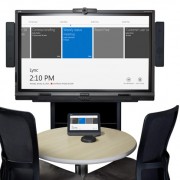To travel or not to travel.
The business case for video conferencing is often based on tangible reductions in travel costs. But is that the full picture? Deirdre Cashion reports.
The most obvious and immediate benefit of video conferencing is the reduction in travel costs. There’s little doubt that this tangible, measurable gain appeals to financial directors in particular, who can tick the box for high-yield cost/benefit analysis with a certain degree of confidence.
However, the video conferencing debate has moved beyond a simple question of cost reduction to encompass collaboration and teamwork and competitive differentiation.
“We’re seeing an uptake in solutions that facilitate both personal and group video,” explained Alan Brown, business director with O2 Ireland. “There is still very much a demand for group video solutions, which enable collaboration among remote teams, while one-to-one video is more common in customer engagement.”
In fact, desktop collaboration solutions such as Lync and Webex are claiming their fair share of the visual collaboration ecosystem. Some would claim their entry to the market may even be cannibalising traditional video conferencing and telepresence revenues, which according to IDC are in decline for the second quarter in a row.
But whatever the market assessment, some video conferencing manufacturers at least, are looking at their market entry as opportunity rather than threat, and are integrating these desktop applications into their own infrastructure or forming strategic alliances with complementary hardware vendors.
“Microsoft’s decision to bundle its video conferencing solution, Lync, with Exchange email, SharePoint team sites, and traditional office applications as part of its Office 365 offering makes a great deal of sense,” according to Brown.
“Collaborating effectively with suppliers, partners and customers in other markets has become far easier but there is still a need in larger companies for high-quality, on-premise solutions, which can co-exist with the likes of Lync and Webex.”
This move towards more fluid desktop integration is one also adopted by video conferencing manufacturer, Polycom, following its strategic alliance with the software giant.
“The Polycom integration with Lync is very important,” said Sean Holohan, managing director with Videnda. “Microsoft are very strong on the desktop, strong on instant messaging, SharePoint, presence and now voice/video collaboration. Polycom high definition group systems can now register directly to Lync so you have Lync desktop or Lync mobile users and you have a number of high definition meeting rooms that can be brought into the call as well.”
But collaboration is not just about connecting more people across geographic boundaries. It’s about enhancing the collaborative experience, capturing ideas and encouraging more interactive engagement.
Technology distributor, Steljes is finding market success with its interactive SMART boards, which allow presentations to be annotated over using digital ink. Participants can share and add contributions and at the end of the session, the annotated notes can be distributed to the group immediately.
“What’s the point of being able to hear and see each other if one party still has to write everything up on a flipchart or dry whiteboard, wait until the others on the video conferencing link see it and then write their comments on their flipchart/dry whiteboard?” asks Leo McBride, AV business manager with Steljes. “It seems archaic. With SMART Board, meetings instantly become more productive and effective,” he said.
But it’s the integration with Lync through its SMART Room System (SRS) that takes these sessions to a new level according to McBride. Meeting participants – regardless of their location – can engage in virtual and face-to-face meetings with simplified voice, video and data collaboration and the added capability to share content via the digital whiteboard space.
McBride believes SRS represents a “unique way to improve the efficiency and productivity of any organisation”.
While video conferencing is extending the boundaries of collaboration, its proponents are also looking to use the tool as a source of competitive advantage. Creative thinking coupled with a vision of a more networked and connected world is fuelling service delivery innovation, particularly in the retail sector.
“Customers are also looking for ways to use video so they can differentiate themselves from their competitors,” according to Adam Grennan, country manager with Cisco Ireland. “They’re asking how they can they use video to bring their service or offering to the market quicker or work closer with their supply-chain.”
A good example of this concept in action is Cisco’s launch earlier this year of ‘The Lab’ (Learn About Banking) with AIB in Dundrum Town Centre in Dublin.
Powered by Cisco’s high-definition video booths, visitors can set up virtual face-to-face meetings with banking specialists and experts from any bank branch, in real time, a move which Cisco sees as particularly important for rural customers.
The future is video and it could be coming to a place near you, very soon.







Leave a Reply
Want to join the discussion?Feel free to contribute!